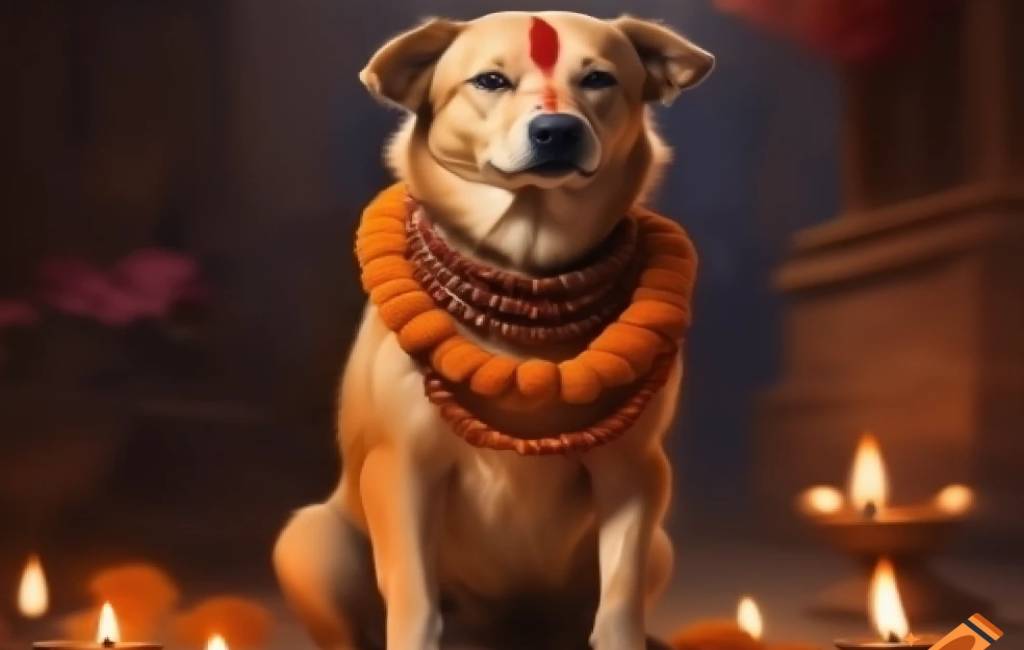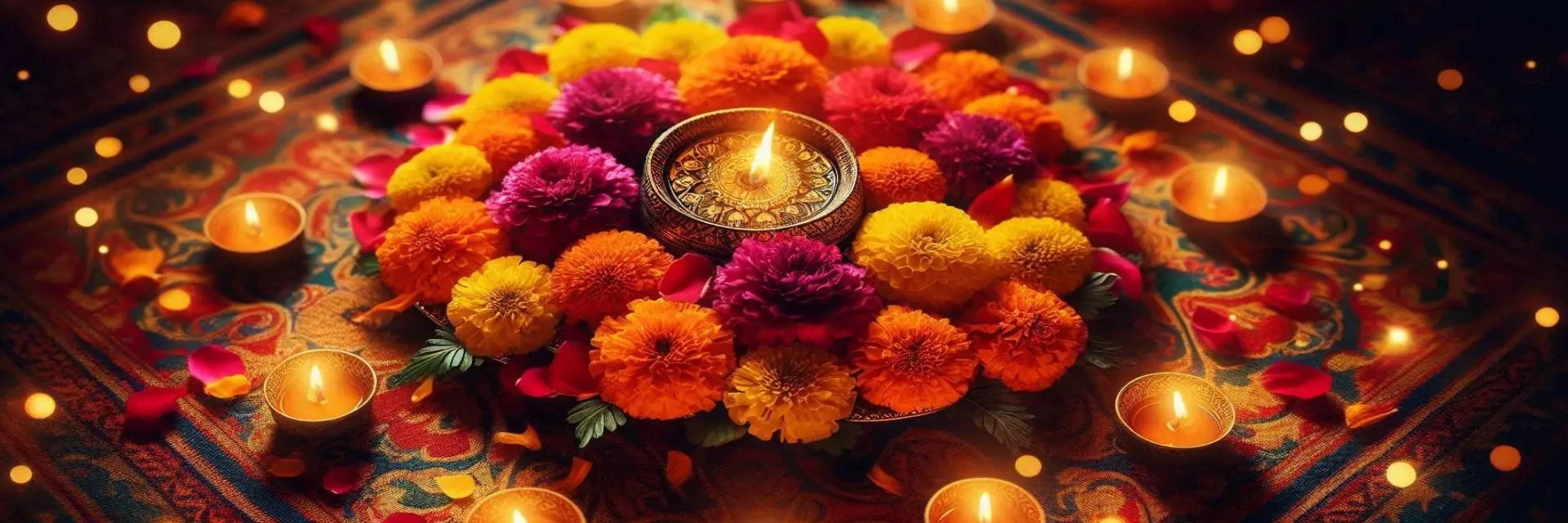What is the story of the Tihar Festival? Legend and Origin
Tihar, also known as Deepawali in Nepal, is a festival deeply rooted in Hindu mythology. One of the central legends associated with Tihar is the story of Lord Krishna's victory over the demon Narakasura. Narakasura was a powerful demon king who terrorized the heavens and defeated the gods.
To end his reign of terror, Lord Krishna waged a battle against him and ultimately defeated him, symbolizing the triumph of good over evil. This event is commemorated during Tihar, particularly on the second day, which is celebrated as Naraka Chaturdashi.
Another significant aspect of Tihar is the worship of Goddess Lakshmi, the goddess of wealth and prosperity. According to Hindu mythology, during the churning of the ocean (Samudra Manthan), Goddess Lakshmi emerged as one of the treasures. To honor her and invite her blessings into their homes, people light oil lamps (diyas), decorate their houses, and perform the Lakshmi Puja. This practice is believed to bring prosperity and happiness to the household.
Not just that, Tihar is also unique in its reverence for animals. Each day of the festival is dedicated to honoring different animals that hold special significance in Hindu culture. The first day, known as Kaag Tihar, is dedicated to crows, believed to be messengers of Yama, the god of death.
The second day, Kukur Tihar, honors dogs, regarded as loyal companions and protectors. The third day, Gai Tihar, is dedicated to cows, revered as sacred animals in Hinduism. Similarly, the fourth day, Goru Puja, honors oxen, essential for farming. These practices highlight the deep connection between humans and animals in Nepali culture.
Kukur Tihar: Celebrating Loyalty and Love Like No Other Festival in the World

Kukur Tihar, part of Nepal’s vibrant Tihar festival, is a truly unique celebration. This day honors dogs for their loyalty, love, and friendship. Unlike any other festival in the world, Nepalese decorate dogs with colorful garlands, tika on their foreheads, and delicious treats. They recognize dogs as faithful companions who bring joy and protection to households.
This special day is not just about pets, it’s a heartfelt tradition reflecting love, respect, and gratitude toward animals. What makes Kukur Tihar in Nepal so different is its deep cultural meaning. While most festivals focus on humans or gods, here the spotlight shines on dogs. This shows the world a rare form of celebration where loyalty and friendship are honored openly and joyfully.
If you ever witness Kukur Tihar, you’ll see why this day is cherished as one of the most unique festivals in the world. This blends tradition, culture, and unconditional love.
What is the story behind Bhai Tika? Brother Sister Bond
Long ago, there was a story about Yama, the god of death, and his sister Yamuna. She loved her brother deeply and prayed that he would visit her before taking her life. When Yama finally came, she welcomed him with flowers, food, and a special tika on his forehead, wishing him long life and protection from death.
Touched by her love, Yama blessed her and said that any brother who receives a tika from his sister on that day will live a healthy, happy life. That’s how Tihar Bhai Tika, the last day of Tihar, began.
Why is Tihar celebrated for 5 days- Yamapanchak
The Tihar festival in Nepal is celebrated for 5 days, as each day carries unique significance. There are very genuine values for each day.
| Day | Name of the Day | Significance | How It is Celebrated |
Day 1 | Kaag Tihar | Honoring crows, the messengers of death. | People offer rice and sweets to crows early in the morning. |
Day 2 | Kukur Tihar | Celebrating the loyalty of dogs. | Dogs are worshipped with garlands, tika, and delicious food. |
Day 3 | Gai Tihar & Laxmi Puja | Worshipping cows and Goddess Laxmi. | Homes are decorated with lights and rangoli to welcome prosperity. |
Day 4 | Goru Tihar / Govardhan Puja | Thanking oxen for their hard work. | People make cow dung mounds symbolizing Govardhan Mountain and worship them. |
Day 5 | Bhai Tika | Celebrating the bond between brothers and sisters. | Sisters apply tika and garland to brothers, praying for their long life. |
Day 1 - Kaag Tihar (Crow Day)
The first day is for worshipping crows, known as messengers of death in Hindu belief. People offer rice, sweets, and grains on rooftops and walls early in the morning. It’s believed that feeding crows keeps bad news and sadness away. The day feels peaceful, simple, and full of small prayers for protection.
Day 2 -Kukur Tihar (Dog Day)
Tihar for dogs is everyone’s favorite day because it’s all about dogs. Do you know, Nepal is the only country that celebrates the dog as a festival? Actually, people put tika and flower garlands around dogs’ necks, give them tasty foods, and treat them like family.
In Hindu belief, dogs guard the gates of heaven, so worshipping them brings loyalty and safety. Even street dogs get love and food on this day, which makes it very heartwarming. So, Kukur Tihar Nepal dog festival is a unique tradition to celebrate loyalty and love.
Day 3 -Gai Tihar and Laxmi Puja (Cow and Goddess Laxmi Day)
On this day, cows are worshipped early in the morning as a symbol of mother and wealth. People feed cows and decorate them with flowers and red tika.
In the evening, everyone lights diyas and candles, cleans homes, and welcomes Goddess Laxmi, the goddess of fortune. Families sing Deusi-Bhailo, share sweets, and enjoy food like sel roti, fruits, and mithai. It’s the brightest night of Tihar.
Day 4 - Govardhan Puja or Mha Puja (Ox or Self Worship Day)
The fourth day is celebrated differently in different parts of Nepal. Some worship oxen for their hard work in farming, while Newar people celebrate Mha Puja, which means worship of the self. It’s about cleansing the soul and bringing positive energy for the new year. Delicious foods, fruits, and home feasts make this day joyful and spiritual at the same time.
Day 5 -Bhai Tika (Brother-Sister Day)
The last day of Tihar is Bhai Tika, the most emotional and loved one. Sisters put colorful tika on their brothers’ foreheads, pray for their long life, and give them gifts. Brothers also give presents in return and promise to protect their sisters forever. Family meals, sweets, and laughter fill the air, ending Tihar with warmth and love that lasts all year.
What is the importance of Tihar?
Tihar festival Nepal is not just a festival, actually, it is an emotion of every Nepali. This festival connects positivity, nature, society, family, and more. Here are the major importance of Tihar, have a look:
Brings light and positivity
Tihar is the festival of lights because people believe lighting diyas removes darkness and invites good luck, peace, and happiness into the home.
Honors Goddess Laxmi
It’s believed that Goddess Laxmi, the goddess of wealth, visits clean and bright homes during Tihar. People pray for prosperity and success for the coming year.
Respects nature and animals
Every day of Tihar honors a living being, like crows, dogs, cows, and oxen. It reminds people that humans and animals are connected and should live with kindness.
Strengthens family bonds
Bhai Tika, the last day, celebrates the pure love between brothers and sisters. It keeps family relationships strong and full of care.
Teaches gratitude and respect
Tihar is about thanking gods, animals, and even the self for life’s blessings. It’s a festival that teaches thankfulness and balance.
Spreads joy and unity
People visit each other’s homes, sing Deusi-Bhailo, and share food. It brings neighbors and communities together, spreading smiles everywhere.
Holds deep spiritual meaning
Tihar shows how light wins over darkness and life wins over death. It connects human emotions with divine beliefs, making it both joyful and sacred.
Tihar Celebration for Foreigners in Nepal
Tihar and Dashain is a great time to visit Nepal. It normally falls in October or November with a pleasant autumn vibe. The weather is supportive, and the cultural rituals will blow your mind.
1. A colorful time to visit Nepal
Tihar is one of the best times for travelers to experience Nepal’s beauty. The whole country glows with lights, flowers, music, and festivals that make every street look magical.
2. Enjoy the local celebrations
Tourists can join Deusi-Bhailo singing with locals, try traditional sweets, and watch homes decorated with rangoli and diyas. It’s the perfect time to feel Nepali culture closely. For your kind information, deusi bhailo is a cultural performance where people sing and dance door-to-door, offering blessings.
3. Visit Kathmandu Valley
During Tihar, the temples and old streets of Kathmandu, Patan, and Bhaktapur look stunning with lights and flowers. You can see people performing Laxmi Puja and hear traditional songs echoing everywhere. Kathmandu Valley tour in the festive season is an unforgettable experience.
4. Put Bhaitika in Rani Pokhari
Bhai Tika is the heartwarming final day of Tihar in Nepal, where sisters pray for their brothers’ long life and prosperity. If you don’t have siblings, don’t worry, even tourists can join the celebration with cousins, friends, or even visit special temples like Balgopaleshwar Temple in Rani Pokhari, Kathmandu. You can watch the colorful tika, garlands, and traditional ceremonies, or even participate with locals to experience a truly unique Nepalese festival of family, love, and blessings.
5. Explore Pokhara at night
Lakeside Pokhara becomes dreamy during Tihar. The reflection of diyas and colorful lights over Phewa Lake looks breathtaking. It’s also great for evening walks and food by the lake.
6. Taste traditional Tihar food
Don’t miss sel roti, anarasa, and homemade sweets prepared specially for Tihar. Many local families and restaurants share these festive dishes with warmth.
7. Capture festival moments
Photographers love this time because Nepal glows in every corner. From candlelit homes to children playing music, it’s full of natural joy and culture.
8. Feel the Nepali hospitality
Tihar is not only about worship, it’s about connection. Locals welcome tourists with smiles, food, and stories, making travelers feel like part of the family.
During this time, Nepal faces the peak tourism season, so the Himalayas, as well as the city and village areas, are already booked. Kathmandu, Pokhara, like major cities, show amazing hospitality amidst cultural twists. Similarly, it is a wonderful time to trek in Everest Base Camp, Annapurna, and Langtang.
Breeze Adventure arranges a wonderful Tihar celebration with unique culture and unforgettable memories in the Himalayas.
Travel Tips for Tihar Nepal
Nepal trip in Dashain Tihar is a blessing that offers many aspects of the Himalayas. Follow the tips below to make this trip worth remembering:
1. Plan your stay early
Hotels and guesthouses get full fast because Tihar is a popular festival. Book in advance to avoid last-minute stress.
2. Respect local traditions
People worship animals, gods, and family members. Join the celebrations politely and follow local customs.
3. Dress comfortably but respectfully
Wear neat and modest clothes when visiting homes and temples. Bright colors are welcomed during the festival.
4. Carry cash
Many small shops, street food stalls, and local events may not accept cards. Cash is handy for buying sweets or gifts.
5. Try local food
Don’t miss sel roti and festival sweets. Street food is safe, but choose fresh and clean options.
6. Capture moments wisely
Photos are beautiful, you can cover locations, culture, and food. Make sure you always ask permission before clicking people or animals, especially during rituals.
7. Join cultural events
Sing Deusi-Bhailo, watch dances, and enjoy music. It’s a fun way to experience the real Nepali Tihar spirit.
8. Be careful with fireworks
Many streets are full of firecrackers. So, it is wise to keep a safe distance and watch children playing safely.
9. Explore decorated cities
Kathmandu, Patan, Bhaktapur, and Pokhara are stunning during Tihar. Take evening walks to see lights and rangoli.
10. Enjoy slowly and respectfully
So, the Tihar festival of Nepal is all about the beautiful connection between humans, birds, and animals. It is joyful and spiritual. Don’t rush, feel the atmosphere, meet locals, and enjoy every small moment.
FAQs for Nepal Tihar Festival
What is the difference between Diwali and Tihar (tihar vs diwali)?
Tihar and Diwali happen around the same time but are a bit different. Diwali is mainly celebrated in India, while Tihar is the Nepali version with extra traditions. In Tihar, people also worship animals like crows, dogs, and cows, not just Goddess Laxmi.
Who celebrates Diwali in Nepal?
Mostly Hindus in Nepal celebrate Diwali, but here it’s called Tihar. People from other communities also join the lights and fun together.
What is the religion of Tihar?
Tihar is a Hindu festival. It honors gods, goddesses, and even animals as part of nature’s blessing.
What is Tihar also called?
Tihar is also known as Deepawali or Yamapanchak in Nepal. It means the festival of lights and brightness.
What is Tihar celebrated for?
Tihar is celebrated to worship Goddess Laxmi and to thank animals like cows, dogs, and crows for their help in human life. It’s also about love and respect between brothers and sisters.
What are the 5 days of Tihar?
The five days are Kaag Tihar, Kukur Tihar, Gai Tihar and Laxmi Puja, Govardhan Puja, and Bhai Tika. Each day has its own special meaning.
How is Tihar celebrated in Nepal?
People decorate homes with lights, flowers, and rangoli. They sing Deusi-Bhailo, worship gods, animals, and share sweets with family and friends.
When is Tihar celebrated in Nepal?
Tihar usually falls in October or November, right after Dashain. The exact date changes every year based on the lunar calendar.
What is the Tihar festival in Nepal?
Tihar is Nepal’s festival of lights and love. It’s one of the biggest Hindu celebrations in the country.
Why is Tihar called the festival of lights?
Because people light diyas, candles, and lamps everywhere. It’s believed the lights invite Goddess Laxmi into homes for blessings.
Why is this festival important?
It teaches respect for life, nature, and family. The festival spreads unity, love, and hope all around.
Can Muslims celebrate Tihar?
Yes, anyone can join the celebration if they wish. In Nepal, people of different religions often enjoy the festival together.
Who celebrates Tihar in Nepal?
Mostly Hindus, but many Nepalis of all faiths take part in it. It’s more about joy and togetherness than just religion.
Why do Nepalese people celebrate Kukur Tihar?
They worship dogs to thank them for loyalty and protection. Dogs are believed to guard the way to heaven in Hindu belief.
What does happy Tihar mean?
It’s a warm greeting used during the festival. It means wishing joy, light, and good fortune to everyone.





